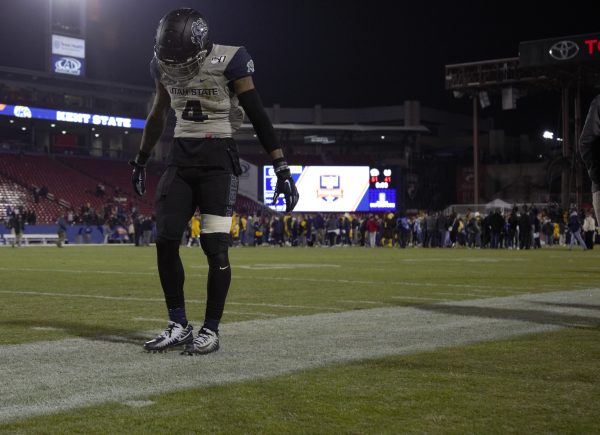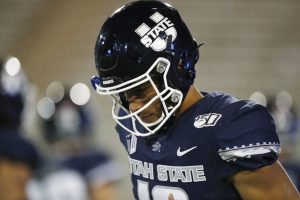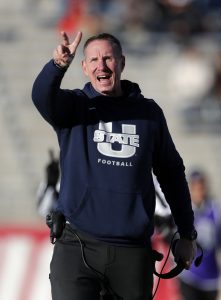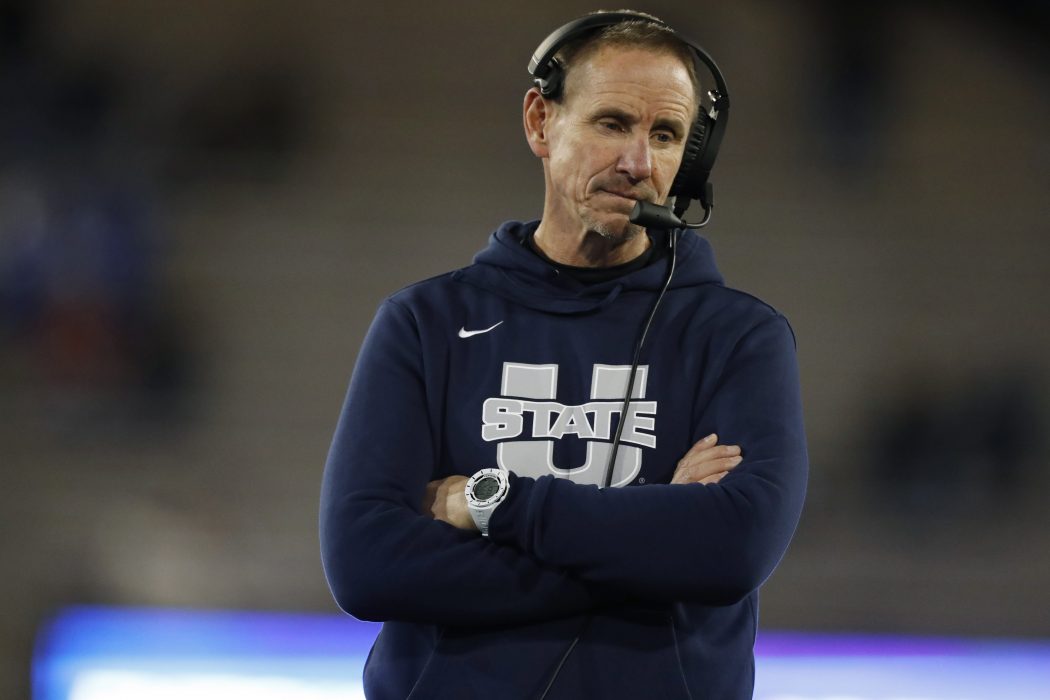A last look at the first year of Andersen’s return to USU
As he addressed the media after his team’s 51-41 loss to Kent State, Utah State head coach Gary Andersen briefly had to talk over the blaring of music bleeding through the windows separating the press conference from the field of Toyota Stadium.
The song? Queen’s 1977 hit “We are the Champions,” a common ballad of victory among high school and collegiate sports teams. In that moment, Andersen had to listen to its celebratory chords with a mildly obscured view of Kent State and its supporters on the field below. All the while he sat in a hard chair, forced to explain why he and his players weren’t out there instead.

Utah State defensive back, Shaq Bond, walks off the field at Toyota Stadium after the Aggies’ 51-41 loss in the Frisco Bowl. Photo by Chantelle McCall
The moment held an eerie similarity to one earlier in the season when, speaking to the media — then in the confines of his own team meeting room — BYU players and coaches could clearly be heard from the locker room below, blasting country music and loudly celebrating the Cougars’ 42-14 victory over USU and reclaiming of the Old Wagon Wheel trophy.
Among other things, these two moments of humiliation summed up all too well much of Utah State’s first season under Andersen’s second stint with the university. A year met with commendable successes, but largely overshadowed by crushing, emotional defeats. Five months plagued with ‘what might have been’ moments.
Finishing the season with a winning mark of 7-6 was no simple task. Andersen noted this himself moments after USU’s final loss of 2019.
“We don’t do what we did and win as many close ball games as we did without being a tough team,” he said.
In his very next breath, however, Andersen highlighted one of the very real shortcomings his team suffered from all season.
“There’s places where the youth need to step up and grow.”
Step up. That was one thing Utah State almost never did in 2019. At least, not when it mattered most. From the very first game of the season all the way until there were triple zeros on the scoreboard in Texas. The Aggies struggled on the biggest stages they appeared on.
At Wake Forest, USU had a chance to take down a Power 5 opponent at last. But three interceptions — including one on the final drive — plus multiple defensive failings shattered those hopes. Four weeks later, on a trip to face the eventual national champions, LSU, the Aggies had a chance to give at the least an impressive showing on a national stage, but wet the bed entirely after a solid start.

Utah State quarterback Jordan Love heads off the field after failing to move the ball late in the second half of an NCAA college football game against Air Force Saturday, Oct. 26, 2019, at Air Force Academy, Colo. Air Force won 31-7. (AP Photo/David Zalubowski)
Even when the early-season gauntlet was put behind them, Utah State couldn’t put to rest its own big-game struggles. In the most crucial matchups of Mountain West play against Air Force and Boise State, the Logan boys of fall laid two unique but entirely complete eggs. Include the loss to BYU and you find that Utah State lost its three most important conference/rivalry games by a combined 87 points, amounting to an average margin of defeat of 29.
The one game with meaning, that held some sort of tangible stakes, which Utah State won was a September matchup with San Diego State. It was a notable win that proved to be USU’s best win of 2019 in terms of quality.
Beating the Aztecs, on their home turf, in California no less, can hardly be overlooked. But in the grand scheme of Utah State’s preseason goals, it checked off none of the boxes. In regard to those goals, USU struck out swinging. Beat a P5 opponent? Nope. Win their division in the Mountain West? Third place. Defeat BYU and keep the Old Wagon Wheel in Logan for a third consecutive year? Not even close. Get to and win a bowl game? Check on the first, not so much the latter.
Coming up so woefully short on essentially every goal is a blemish on the program. This was supposed to be Utah State’s year, a follow-up worthy of being in the same conversation as the historic 2018 team that featured many of the stars who reprised their roles for 2019. If a program like Utah State built up after years in the cellar to finally be able to strike back at opponents that for so long cruelly took advantage of them, what does it say when the team flounders and flops amid its rare chance at greatness.
It’s worse because the modern iteration of Utah State football, one that isn’t mired in perpetual three-win seasons and that actually has preseason expectations, was manufactured by Andersen himself from the ground up. It was then built upon by his successor, Matt Wells, an in-house hire and a product of Andersen’s coaching tree.
Now that the standards have changed, Andersen has to answer questions as to why his squad, which inherited many key pieces from a historic 11-2 team, couldn’t even hold a candle to that bonfire of a season. Though if you were to ask him, Andersen is already well aware that he is responsible for the direction Utah State, as a program, is heading.
“That dissection starts with me tonight,” Andersen said. “Personally making sure that I am doing everything that I can for these kids in every way, shape and form. There’s a lot of branches that branch off of that area that you dissect every year, every ounce of the football program. Every coach, every player, every trainer, every manager, every film, every play, I have to dissect myself first.”

Utah State coach Gary Andersen shouts instructions from the sideline during the first half of an NCAA college football game against New Mexico on Saturday, Nov. 30, 2019 in Albuquerque, N.M. (AP Photo/Andres Leighton)
Perhaps coaching can explain some of the Aggies’ shortcomings in 2019. Or perhaps there are other explanations for regression in areas the 2018 team dominated in. Junior quarterback Jordan Love saw significant regression in completions percentage, touchdowns and interceptions. The defense, on the other side of the ball, went from stopping just about anything to seemingly not being capable of tackling a stationary dummy.
Whether coaching is to blame for these regressions or not, there’s only so loud a coach can yell before his players have to perform on game day and prepare on the practice field and in the weight room.
“I feel we need to work out as Mountain West champs every week.” junior safety Troy Lefeged Jr. said. “I feel like we have to get everybody to buy in and believe in it. That starts with us. We have to get everybody on board. I want to get this taste out of my mouth, for the seniors too, because I feel like I let them down. Next year we’re going to come back hard, especially with this man next to me [Coach Andersen].”
At the end of the day and end of the season, there’s a silver lining to the mound of disappointments left by the 2019 season. Fifteen or so years ago, a 7-6 season would be heralded as a smashing success. After all, Andersen’s 2011 season — his second year with the program — which was also a 7-6 year with a bowl loss, ended a 17-year drought of winning seasons and bowl appearances spanning 1994 and 2010. The ability to be disappointed in a winning season is a blessing in disguise.
Still, this isn’t 15 years ago. If Utah State plans on continuing its growth over the past 10 years, this overall season failure has to be learned from and then forgotten underneath 10 more years of further growth and greater gridiron glory.
If not, Andersen will quickly wear out the welcome of his return to Logan. Perhaps he recognized this. The moves to hire Bodie Reeder and shake up the top end of the defensive staff can’t be coincidental with the decline from 2018 to 2019 despite similar talent levels on the two teams. There’s hope yet for Andersen’s return. He began his Aggie career with back-to-back 4-8 seasons before going 18-8 in a two-year span. If he can repeat that feat (and maybe stick around a little longer), he’ll retire in Logan a program hero.

